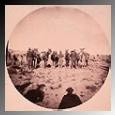
THE HEMENWAY EXPEDITION
From the
Peabody Museum Archives
Harvard University
In 1879, Frank Hamilton Cushing, a leading Smithsonian
ethnologist, was asked by the Bureau of American Ethnology to join a
collecting expedition that traveled to the Zuni Pueblo in New Mexico.
Here Cushing became convinced that a long- term stay was necessary to
conduct his research using pioneering anthropological methodologies of
participant-observer and the uniqueness of the "Zuni idea" of culture
(Haskell, 1993, p. 10). The Hemenway Expedition to the Southwest was
conceived in the summer of 1886, after Cushing sent an appeal to Mrs.
Mary Hemenway of Boston. Mary Hemenway was an outstanding
philanthropist who passionately supported historic preservation in
Boston, many and varied educational efforts, and "a perspective from
which to cope with the rapid changes of a new urban and industrial
order (ibid, pp.5-6)." Cushing's enthusiasm and his concept that
"archaeology is simply ethnology carried back into prehistoric times"
(ibid, p.14) persuaded Hemenway that this would be an expedition worth
backing to the tune of an initial investment of $100,000.
The Hemenway Expedition focused on the ethnological, the
anthropological, the historical, and the archaeological. The Expedition
arrived in New Mexico in December 1886, went to Arizona to excavate in
January of 1887, and returned to Zuni in June 1888. During that time
Cushing and the other expedition members (Cushing's wife Emily Magill,
his sister- in-law and artist Margaret Magill, anthropologist Dr.
Herman F.e. ten Kate, historian Dr. Adolf Bandelier, topographer and
field manager Charles Garlick, general secretary and draftsman
Frederick Webb Hodge, and comparative anatomist Dr. J.L. Wortman)
excavated eleven sites, including thirty- four compounds at Los Muertos
while conducting ethnographic research among the local populations. In
May of 1889 Jesse Walter Fewkes, a classmate of Mary's son Augustus,
was appointed supervisor of digging, and soon took over the expedition
due to Cushing's failing health. In 1891 Fewkes moved the expedition to
Hopi. The Hemenway Expedition continued until 1894 when Mary Hemenway
died at age 74.
Mary Hemenway's son Augustus funded another expedition to
Arizona in 1913-14. This expedition was archaeological in nature.
Hemenway hired Charles Clark Willoughby and R G. Fuller to explore
various Chinlee Valley sites including Mesa Verde and Tseonitsosi Canon.
|



